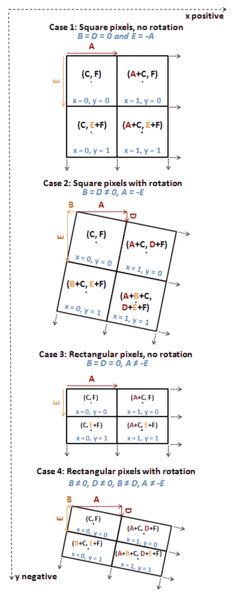When I run gdalinfo (v2.2.2) on a geotiff that I created from a pdf using gdal_translate, I don't get the pixel size as shown in the docs. Does the pixel size have to be explicitly stored in the tif in order for gdalinfo to report it? If so, can gdal_translate be coerced to store the value when the tif is written?
>gdalinfo NM_Canada_Ojitos_20170216.tif
Driver: GTiff/GeoTIFF
Files: NM_Canada_Ojitos_20170216.tif
Size is 3412, 4350
Coordinate System is:
PROJCS["NAD83 / UTM zone 13N",
GEOGCS["NAD83",
DATUM["North_American_Datum_1983",
SPHEROID["GRS 1980",6378137,298.257222101,
AUTHORITY["EPSG","7019"]],
TOWGS84[0,0,0,0,0,0,0],
AUTHORITY["EPSG","6269"]],
PRIMEM["Greenwich",0,
AUTHORITY["EPSG","8901"]],
UNIT["degree",0.0174532925199433,
AUTHORITY["EPSG","9122"]],
AUTHORITY["EPSG","4269"]],
PROJECTION["Transverse_Mercator"],
PARAMETER["latitude_of_origin",0],
PARAMETER["central_meridian",-105],
PARAMETER["scale_factor",0.9996],
PARAMETER["false_easting",500000],
PARAMETER["false_northing",0],
UNIT["metre",1,
AUTHORITY["EPSG","9001"]],
AXIS["Easting",EAST],
AXIS["Northing",NORTH],
AUTHORITY["EPSG","26913"]]
GeoTransform =
319569.9072199312, 4.06320686118055, -0.08151911420909382
4042818.402645736, -0.08151911420909382, -4.06320686118055
Metadata:
AREA_OR_POINT=Area
AUTHOR=USGS National Geospatial Technical Operations Center
CREATION_DATE=D:20170216103259Z
CREATOR=ESRI ArcSOC 10.0.2.3200
KEYWORDS=Topographic, Transportation, Hydrography, Orthoimage, U.S. National Grid, imageryBaseMapsEarthCover, Imagery and Base Ma
s, Geographic Names Information System
NEATLINE=POLYGON ((332137.201278231 4041102.99001007,331856.525171518 4027113.079869,320528.939318619 4027340.34242206,320809.615
25332 4041330.25256312,332137.201278231 4041102.99001007))
SUBJECT=This image map depicts geographic features on the surface of the earth. It was created to provide a representation of ac
essible geospatial data which is readily available to enhance the capability of Federal, State, and local emergency responders for
omeland security efforts. This image map is generated from selected National Map data holdings and other cartographic data.
TITLE=USGS 7.5-minute image map for Canada Ojitos, New Mexico
Image Structure Metadata:
COMPRESSION=DEFLATE
INTERLEAVE=PIXEL
Corner Coordinates:
Upper Left ( 319569.907, 4042818.403) (107d 0'53.88"W, 36d30'49.40"N)
Lower Left ( 319215.299, 4025143.453) (107d 0'53.29"W, 36d21'15.87"N)
Upper Right ( 333433.569, 4042540.259) (106d51'36.58"W, 36d30'49.43"N)
Lower Right ( 333078.961, 4024865.310) (106d51'37.13"W, 36d21'15.87"N)
Center ( 326324.434, 4033841.856) (106d56'15.22"W, 36d26' 2.73"N)
Band 1 Block=3412x1 Type=Byte, ColorInterp=Red
Band 2 Block=3412x1 Type=Byte, ColorInterp=Green
Band 3 Block=3412x1 Type=Byte, ColorInterp=Blue



